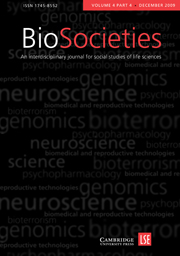The articles in this issue offer an unusual opportunity for all of us to discover afresh the fact that even scholars who work on quite different topics have much to learn from one another’s analyses. Here we have papers engaging themes as diverse as psychotropic drugs, stem cell technologies, and the genetics of breast cancer, and yet collectively they suggest that some well-developed, even classic analytic touchstones from the social sciences— gender, culture, the family, national identity—are still productive for our efforts as scholars to make sense of the new and even the cutting edge. There is much in the world of the life sciences that may demand new analytic frames of reference, but it is good to be reminded that we should not fetishize our interest in analytic novelty.
Take the way in which both gender and culture are invoked by Giovanni Frazzetto et al. to illuminate both the regulatory processes and activist resistances to the stimulant drug treatment for children with attention deficit/hyperactivity disorder (ADHD) in Italy. The article suggests that the Italian cultural context—a strong valuing of family, alongside an historic, political and clinical disapproval of biological psychiatry and its drug treatments—creates a battleground in which ‘children’s rights’ to the good life is the key rallying cry for all sides. Interestingly, the authors find that, unlike in the United States, gender is not deployed as a polemic tool in the Italian debates over ADHD-type behaviours and drug treatment. This may be because the value of family as a whole is greater than the sum of its parenting parts, and both parents therefore engage in activist work to either resist or rally on behalf of ADHD diagnosis and stimulant treatments. A cultural valuing of family as the cornerstone of civic sensibility and meaning is similarly deployed in the Italian debates over embryonic stem cells. In her article on ‘Nationalizing embryos’, Ingrid Metzler argues that in the Italian context, family is a ‘political technology’, used to galvanize legislative protections for Italy’s smallest citizens: Italian embryos. Metzler indicates the subtle, but important, interactions with Italian gender politics, in that prioritizing the rights of the embryo allowed the Italian government to enforce a ‘Catholic morality’ that restricted women’s access to certain kinds of assisted reproduction interventions, essentially restricting women’s rights to make their own decisions with regard to their bodies.
The production of biological material—stem cells, foetal tissue, embryos—is a deeply embodied experience, involving common, often stigmatizing conditions for women such as involuntary childlessness and abortion. In their article, Naomi Pfeffer and Julie Kent argue that current UK regulatory distinctions between aborted foetuses and pre-implantation embryos instantiate disempowering views of women as passive, overly altruistic and in need of ethical protections. The energetic three-way discussion and review in this issue’s Book Forum suggests that women’s experiences of genetic counselling for breast cancer—another stigmatizing condition—can be imbued with similarly disempowering assumptions about women. In this context, ‘family’ is again a moral trope around which scientific and social practices interact. Our reviewer, Karen Sue Taussig, shows how Sahra Gibbon’s ethnographic study of BRCA genetics and health activism in the UK reveals the gendered nature of rights and responsibilities that come with genetic futures: women’s responsibility to know their risk for breast cancer is scripted as a ‘gendered obligation to take responsibility not only for one’s own, but for one’s family’s future’. Women with risk of breast cancer need to ‘own’ their responsibilities to family, but their rights to ownership of their genes have been contested by Myriad Genetics’ attempts to patent the BRCA 1 and 2 genes. Efforts to commercialize breast cancer genetics were much stronger in the US than in the UK. Taussig’s review includes Shobita Parthasarathy’s book on the comparative institutional and political cultures in the US and UK that surround breast cancer genetic testing. Parthasarathy’s argument takes us back full circle to the importance of gender and culture in shaping individual experiences of disease and embodied risk. Taussig adds a caution about the use of ‘culture’ as an analytic concept outside anthropology, which reminds us to continually interrogate our use of these broad terms in order to avoid emptying them of their analytic power.
Along with these articles, the issue includes a commentary on a current ‘hot’ topic at the intersection of science and social science. Hugh Pennington, unusual in the UK for his outspoken public profile on issues of biosecurity, writes about the (re)emerging problem of foot and mouth disease in the UK. As well as providing a fascinating and perceptive historical overview of the UK’s struggles with foot and mouth disease, Pennington reflects on the intersections between the problem of escaping viruses and current approaches to biosecurity in the UK that these days concern us all.

